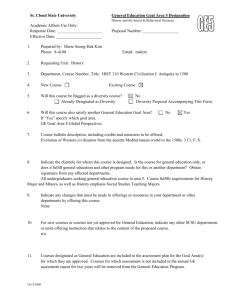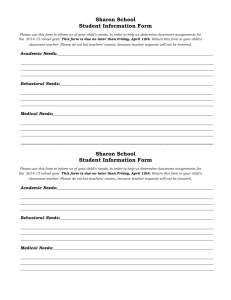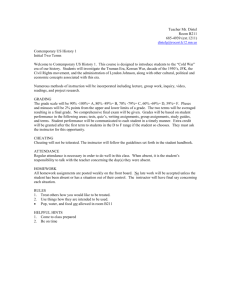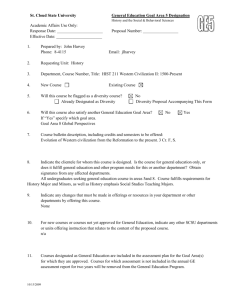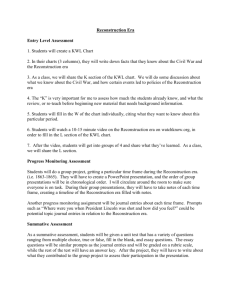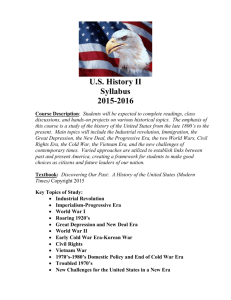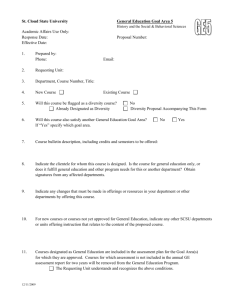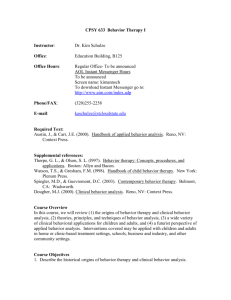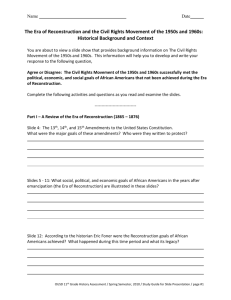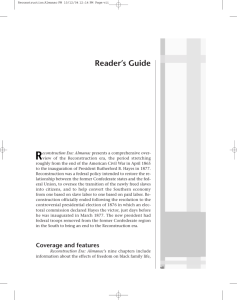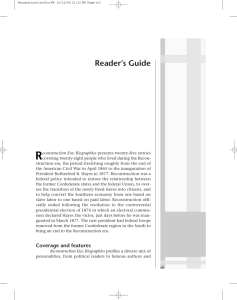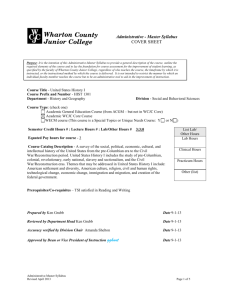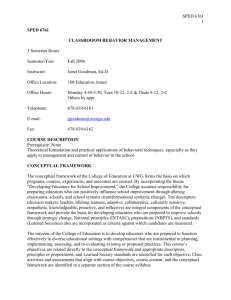St. Cloud State University General Education Goal Area 5
advertisement
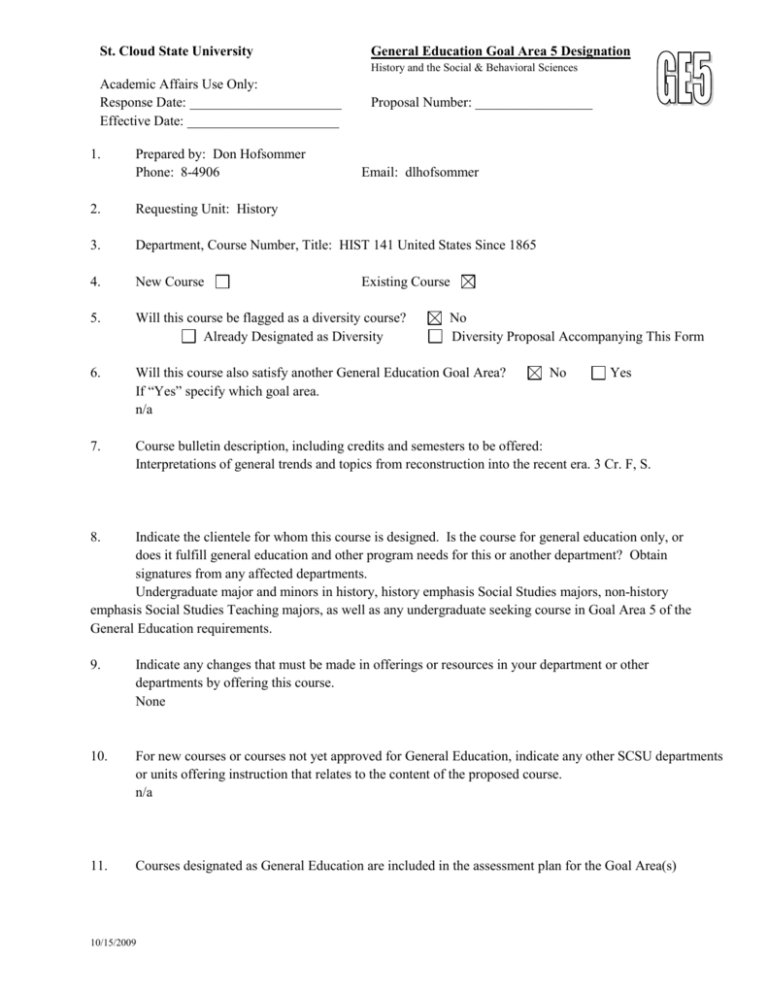
St. Cloud State University General Education Goal Area 5 Designation History and the Social & Behavioral Sciences Academic Affairs Use Only: Response Date: ______________________ Effective Date: ______________________ 1. Prepared by: Don Hofsommer Phone: 8-4906 Proposal Number: _________________ Email: dlhofsommer 2. Requesting Unit: History 3. Department, Course Number, Title: HIST 141 United States Since 1865 4. New Course 5. Will this course be flagged as a diversity course? Already Designated as Diversity 6. Will this course also satisfy another General Education Goal Area? If “Yes” specify which goal area. n/a 7. Course bulletin description, including credits and semesters to be offered: Interpretations of general trends and topics from reconstruction into the recent era. 3 Cr. F, S. Existing Course No Diversity Proposal Accompanying This Form No Yes 8. Indicate the clientele for whom this course is designed. Is the course for general education only, or does it fulfill general education and other program needs for this or another department? Obtain signatures from any affected departments. Undergraduate major and minors in history, history emphasis Social Studies majors, non-history emphasis Social Studies Teaching majors, as well as any undergraduate seeking course in Goal Area 5 of the General Education requirements. 9. Indicate any changes that must be made in offerings or resources in your department or other departments by offering this course. None 10. For new courses or courses not yet approved for General Education, indicate any other SCSU departments or units offering instruction that relates to the content of the proposed course. n/a 11. Courses designated as General Education are included in the assessment plan for the Goal Area(s) 10/15/2009 for which they are approved. Courses for which assessment is not included in the annual GE assessment report for two years will be removed from the General Education Program. The Requesting Unit understands and recognizes the above conditions. 12. Provide a concise explanation of how the following goal is a “significant focus” of the proposed course. Goal Area 5: History and the Social & Behavioral Sciences Develop understanding of human societies and behaviors, and of the concepts, theories, and methods of history and the social sciences. Through the examination of U.S. History since 1865 students will acquire a familiarity with major events and figures as studied via the diverse populations and concerns. The student will also develop skills in critical reading of both primary and secondary sources, in research, in the comprehension of textual and lecture material, in class discussion, and in the composition of essays. 13. In order for a course to be designated as fulfilling Goal Area 5, it must address at least 4 of the 5 student learning outcomes (SLOs) below. Check the SLOs below that are focused on in the proposed general education course. 1. Describe or use the methods and data by which historians, social scientists, or behavioral scientists investigate human conditions. 2. Analyze human behavior, cultures, and social institutions and processes from the perspectives of history or the social and behavioral sciences. 3. Develop explanations for and explore solutions to historical or contemporary social problems. 4. Reflect upon themselves in relation to family, communities, society, culture, and/or their histories. 5. Apply and critique alternative explanatory systems or theories about human societies and behaviors. 14. Discuss how each Student Learning Outcome checked above is achieved in this course. (Note: Although descriptions of typical assignments or types of assignments may be part of this discussion, it is not appropriate to submit copies of actual assignments.) 1. Students acquire historical knowledge of the American experience in the context of world development. 2. Students learn how to critically evaluate historical data by analyzing primary and secondary sources. 3. Students sharpen rational and comprehensive arguments in written and oral presentations. 4. and 5. Students are obliged to compare their historical understanding against political, social, cultural, and economic issues of the day. Assessment of thse learning objectives is done through examinations, written assignments, and oral presentations. 15. List or attach the Course Outline (adequately described and including percentage of time to be allocated to each topic). Curriculum Committees may request additional information. Topics larger than 20% need to be broken down further. Indicate in your course outline where the Student Learning Outcomes checked above are being met. The Student Learning Outcomes are met throughout the curriculum described in the course outline below: I. Introduction: Nature of History 1% 10/15/2009 II. The Reconstruction Era, 1865-1877 10% A. Presidential and Congressional Policies. B. Reconstruction in the South C. Post-Reconstruction: The Triumph of White Racism III. The Age of Economic Revolution, 1865-1900 10% A. Industry Comes of Age. B. The Responses of Business, Labor and Agriculture to Industrialism IV. Social Trends: Urbanization and Industrialization, 1860-1910 10% A. Urbanization in an Age of Industrialism B. Immigrants and Nativism in Industrial America V. The Progressive Era, 1900-1916 10% A. Progressivism: Urban Middle Class Reform, Social Justice, Suffrage, Municipal Reforms. B. Theodore Roosevelt and the Profressive Movement. C. Woodrow Wilson and the Flowering of the Progressive Movement. VI. Foreign Expansion, 1898-1920. 5% A. The Acquisition and Administration of Colonial Empire. B. The Road to War: The End of Isolationism. C. The Paris Peace Conference and the Fight Over the League of Nations. VII. The 1920s. 10% A. An “Era of Wonderful Nonsense” or “The Formative Era?” B. Socio-cultural Conflict: Prohibition, the KKK and the Anti-Evolution Crusade. C. The Economy in the 1920s: The Prosperity Decade? VIII. The Great Depression and the New Deal, 1929-1939. 10% A. The Stock Market Crash and the Causes of the Great Depression. B. The Social Impact on the Depression. C. FDR and the New Deal: The Emergence of the Welfare State. IX. The United States and World War II, 1939-1945. 10% A. The Origins of U.S. Involvement. B. American Diplomacy during World War II. C. The American Home Front. X. The Cold War, 1945-1969. 10% A. The Origins of the Cold War. B. Containment in Europe: A Revolution in Foreign Policy C. Containment in the Far East and Southeast Asia, 1950-1953. D. The Eisenhower Years: The Impact of Containment on the Third World. E. The 1960s in Foreign Relations: Vietnam. XI. Some Postwar Domestic Trends, 1945-1969. 10% A. The Emergence of an Affluent Society B. Consumer Culture. C. The Black Revolt. D. The Student Movement. E. The Revival of Feminism. XII. America at Home & Abroad: 1970-2000 4% A. Malaise: The 1970s B. Reagan & Bush: Conservative Ascendancy? C. End of the Cold War 10/15/2009 D. Clinton: Liberal Ascendacy? 10/15/2009
